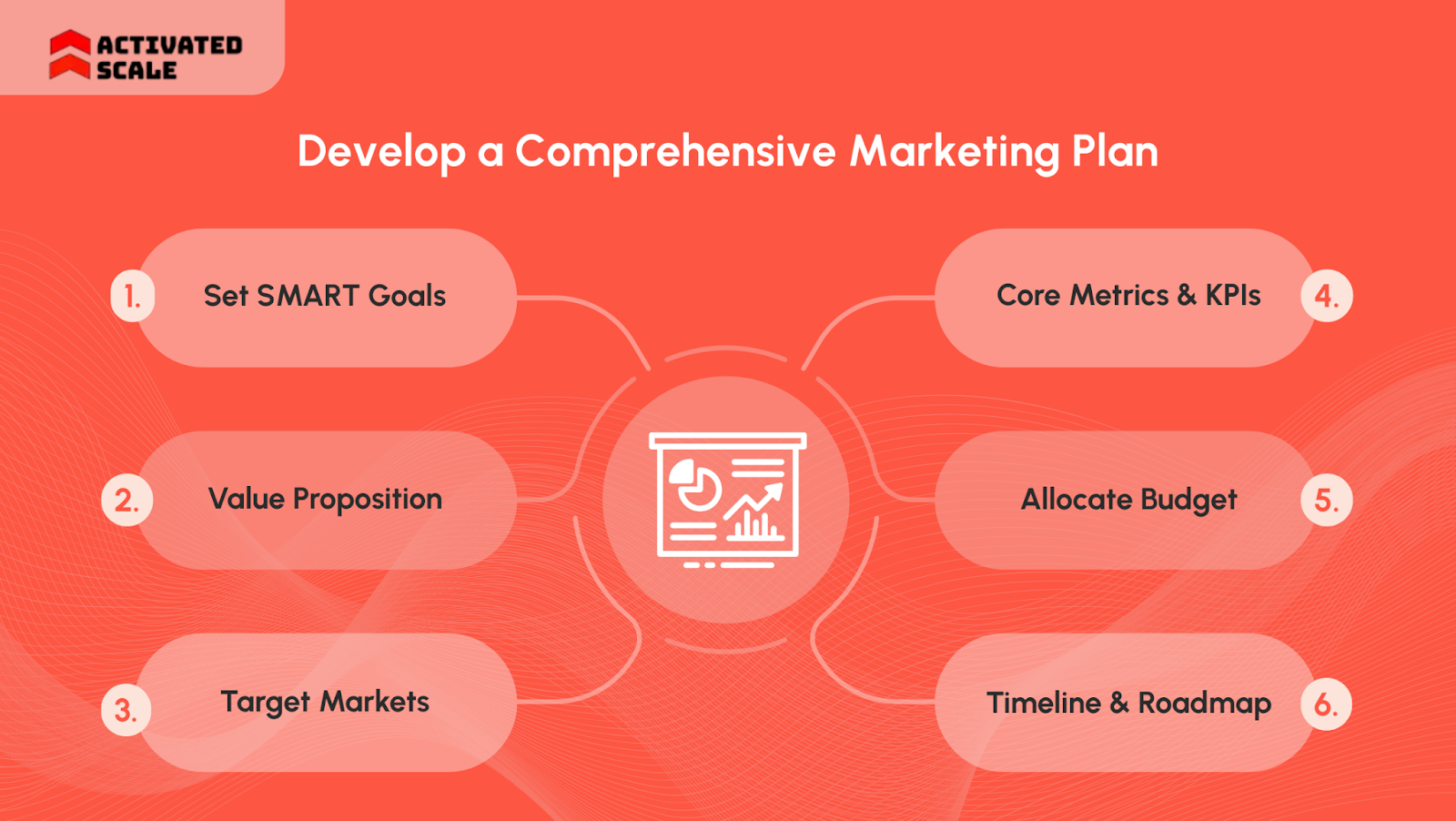Starting a company is exciting. But getting noticed in a crowded market is one of the most complex challenges for founders.
According to Failory, 56% of startup failures come down to marketing problems. The biggest issue is a lack of product-market fit.
Still, in 2025, many teams invest heavily before validating whether people actually want what they are offering. In this age, you may have built something valuable, but without clear messaging and visibility, customers will never find it.
Overspending on campaigns that do not convert can quickly shorten your runway. It is normal to feel stretched when balancing product, fundraising, and marketing.
The good news is that practical, low-cost strategies can help you win attention without draining your runway.
In this guide, we focus on the tactics that matter most for early-stage teams under pressure to show traction, attract customers, and prove growth to investors.
Key Takeaways for Startup Founders and Revenue Leaders
- Strong foundations save money later: A clear brand story, defined personas, and consistent messaging reduce wasted spend.
- Focus beats variety: Choose a few channels that align with your ICP instead of spreading resources too thin.
- Consistency builds trust: Regular content, steady communication, and aligned branding compound over time.
- Measurement drives efficiency: Simple metrics like conversions and CAC allow for more intelligent allocation.
Why Marketing Matters for Startups

For founders and SaaS leaders, marketing is not just another task. It is the foundation that determines whether a business gains traction or fades away:
- Brand identity and awareness: Early-stage companies require a distinct presence to differentiate themselves. A clear story and consistent branding help you stand out and be remembered.
- Customer acquisition and retention: Marketing is the engine that brings in first customers and keeps them engaged. Retention builds a loyal base and stabilizes revenue.
- Product validation and feedback: Marketing channels double as listening posts. Campaign data and customer responses show if your product resonates or needs refinement.
- Investor confidence: A solid marketing plan demonstrates you know your market. Showing traction with customers builds credibility when raising capital.
- Competitive advantage: In crowded sectors, startups that communicate clearly and position well can win share even against larger players.
Strong marketing provides clarity and credibility, and the first step is building a solid foundation. Let’s explore how this is achieved in Phase 1.
Phase 1: Lay the Foundation for Startup Marketing

Strong marketing starts with strong fundamentals. Early-stage teams that invest time in the basics build credibility faster and avoid wasting budget later.
1. Define Your Brand Story
Your brand story is more than background. It is a repeatable explanation of why you exist, who you serve, and how you are different.
- Focus on mission: Define the core problem your startup solves. Show why addressing this challenge is meaningful for your customers and industry.
- Highlight audience: These are the people who benefit from your solution.
- Share your origin: Explain the inspiration behind starting your company. A relatable origin story builds trust and emotional connection with your audience.
- Show differentiation: With so many startups operating, the market needs to know why your approach is unique.
Pro Tip: Keep your story short enough to deliver in 30 seconds.
2. Clarify Your Values and Voice
Your values guide decisions, and your voice determines how you sound to the market.. Together, they create trust and consistency:
- List 3 to 4 values: These serve as non-negotiables for your business, ensuring messaging alignment.
- Decide on tone: Professional, approachable, or bold. Regardless of your choice, your tone should reflect your audience’s expectations.
- Write sample lines: Test how your brand voice feels in short statements before rolling it out widely.
- Onboard your team: Even small startups need internal consistency. Every employee should communicate in the same voice.
3. Conduct Market Research
Market research validates assumptions and reduces risk. Ensure that your idea fits the demand before you scale.
- Talk to early adopters about pain points.
- Review competitor positioning and pricing.
- Use free tools like Google Trends, Crunchbase, or LinkedIn.
- Test simple surveys or polls with target customers.
- Segment findings by role, industry, or company size.
Pro Tip: Revisit your research quarterly to stay aligned with market shifts. The market is constantly changing, and you need to keep adapting to it.
4. Document Buyer Personas
Personas give clarity on who you are selling to and why they care. They should be based on evidence, not guesses.
- Define the goals and pain points of your ideal buyer.
- Capture decision-making behavior and buying triggers.
- Identify potential objections they might raise during the sales process.
- Document preferred channels of communication.
- Share personas with sales leaders and marketing folk for alignment.
5. Craft Clear Messaging
Customers want to know how you help them succeed. Messaging must be simple, consistent, and outcome-driven.
- Lead with benefits and results, not product features.
- Create a one-line value statement for each persona.
- Test versions in conversations and refine what resonates.
- Avoid jargon or technical terms unless your ICP uses them.
6. Set Up Your Digital Presence
Your website and digital footprint create the first impression. When someone who’s part of your TAM (total addressable market) searches for you, your website must show up. Otherwise, you will lose a potential lead.
Also, initially, your website doesn’t need to be complex, but it must be credible.
- Keep things neatly designed but ensure that the website is responsive and mobile-friendly.
- Use clear calls to action on each page.
- Add analytics to measure traffic and conversions.
- Create at least one landing page for lead capture.
- Build a LinkedIn company page and founder profile.
- Establish presence on one or two channels where your ICP spends time.
Strong foundations give startups a faster ramp, reduce wasted spending, and create the credibility that buyers and investors look for early on.
Phase 2: Develop a Comprehensive Marketing Plan

Once the basics are in place, the next step is creating a plan that directs execution. A clear roadmap helps startups focus resources, align teams, and measure results without wasting budget.
1. Set SMART Goals
Founders often try to chase everything at once. SMART goals bring focus by being specific, measurable, attainable, relevant, and timely. They allow you to commit resources to a few critical outcomes rather than spreading energy too thin.
Aim for goals like:
- Grow inbound leads by 30 percent in six months.
- Publish two new sales-driven blogs per month.
Pro Tip: Tie every goal back to revenue. This will prevent you from overspending in one area. It will also show investors that you’re going to be responsible with your funds.
2. Define Your Value Proposition
Your value proposition is the single most apparent reason customers should choose you. It must connect directly to pain points and outcomes.
Write it as if you are answering a founder’s key question: Why should I switch to this solution now?
- State the problem you solve in plain language.
- Highlight the outcome your product creates.
Example: Slack’s early value proposition wasn’t “team communication software.” It was framed as “Be less busy,” a simple promise that spoke to overwhelmed teams looking to cut email overload, reduce meeting time, and streamline communication.
That message resonated emotionally and clearly explained the outcome.
3. Identify Target Markets
Not every audience is worth chasing in the early stage. Startups that define their ICP early build momentum faster. Begin by analyzing who is most likely to adopt quickly and get the most value.
Segment your market by:
- Roles (founders, sales leaders, operations managers)
- Stage of growth (seed, Series A, bootstrapped)
Once you know who to target, focus campaigns where they already spend time. For SaaS teams, LinkedIn groups or specialized Slack communities often outperform broad social platforms.
4. Choose Core Metrics and KPIs
Investors and boards look for proof of traction. Metrics show whether your marketing is creating momentum. Without them, it’s impossible to refine strategy.
Focus on a small set that matters most in the early stage:
- Customer Acquisition Cost (CAC)
- Lifetime Value (LTV)
- Conversion rates at key funnel stages
Tracking these helps founders show ROI without drowning in vanity metrics.
5. Allocate Budget and Resources
Even lean budgets can produce results if allocated strategically. Startups often see the best return from channels like content, SEO, and email because they scale with time rather than cash.
Set aside a portion of the budget for controlled experiments. Testing a paid campaign, trialing a tool, or sponsoring a niche event can unlock insights that shape future investment decisions.
- Dedicate at most 15-20 percent of the budget to experimentation.
- Review spending quarterly and reallocate toward top-performing channels.
6. Create a Timeline and Roadmap
Without clear timelines, even the best marketing plan remains abstract. Milestones create accountability and help your team track progress against investor expectations. Breaking initiatives into clear phases ensures that progress feels achievable rather than overwhelming.
- 30 days: update website messaging and publish first case study
- 60 days: secure one media mention and test a referral program
- 90 days: generate consistent inbound leads from organic channels
Example: A fictional SaaS startup, PipelinePro, set a 90-day roadmap where the first month focused on refining their pitch deck, the second on publishing customer stories, and the third on hosting a webinar. By tying activities to milestones, they avoided distractions and stayed investor-ready.
Planning reduces waste in marketing. For sales capacity, Activated Scale offers a similar advantage by connecting founders to vetted, U.S.-based SDRs, AEs, and fractional leaders without long hiring cycles.
Book a 30-minute call with Activated Scale to meet vetted U.S.-based reps ready to generate pipeline.
A clear plan helps founders stay disciplined, align teams around priorities, and show investors that your growth is intentional.
Phase 3: Use Low-Cost Digital Strategies As Add-Ons

With a clear plan in place, the next step is execution. These low-cost digital strategies give startups a way to grow visibility and prove traction without stretching budgets:
1. Content Marketing
Content creates trust and demonstrates expertise. Even a light publishing cadence can deliver results.
- Answer common questions: Write posts that address recurring challenges faced by founders or buyers.
- Repurpose for reach: Turn blogs into LinkedIn posts, email snippets, or short videos.
- Add simple visuals: Use screenshots or graphics to make the material easier to scan.
2 . Search Engine Optimization (SEO)
SEO compounds over time, and 53% of your website visitors will come from organic traffic. Hence, SEO is one of the most efficient long-term bets for early teams.
- Optimize your site copy: Use phrases your ICP searches for, not jargon
- Check technical basics: Speed, mobile readiness, and straightforward site structure matter/
- Link internally: Connect related pages and blogs to strengthen rankings
3. Social Media Marketing
Social channels offer free distribution, but spreading across too many reduces impact. Choose where your ICP already spends time.
- Pick one or two networks: LinkedIn often works best for B2B startups
- If you plan to extend sales efforts alongside marketing, focus on U.S.-based reps who understand American buyers and cycles.
- Engage directly: Share updates, polls, or customer stories to start conversations.
- Stay authentic: Short lessons learned or founder insights build more trust than polished ads.
4. Email Marketing
Email marketing continues to deliver high ROI, returning an average of $36 for every $1 spent.
- Start with a simple sequence: A welcome note, a weekly tip, and occasional updates are enough
- Personalize where possible: Address subscribers by role or interest to improve engagement
5. Digital PR
Earned media can add credibility that paid ads often cannot. A single article in the right niche can open doors.
- Pitch thought leadership: Offer practical insights to industry blogs or newsletters.
- Highlight milestones: Share new launches, partnerships, or customer stories.
These digital strategies give startups a cost-effective way to gain visibility, earn trust, and prove traction before investing heavily in paid campaigns.
Consistent use of these tactics builds visibility and provides the traction points founders need when raising capital or hiring their first sales reps.
6. Building a Strong Sales Team
While these digital strategies bring in awareness and leads, they only create impact if there is a strong sales engine to convert them into paying customers. A skilled sales team ensures the pipeline generated through content, SEO, and email does not go cold. Early-stage startups often underestimate this step, but sales is where traction turns into revenue.
Founders should prioritize training, alignment, and consistent follow-up practices within the sales team. Activated Scale can provide structured frameworks for sales readiness, playbooks to guide conversations, and tools that streamline the lead-to-customer journey.
With the proper sales structure in place, startups can maximize ROI on every marketing effort and build a sustainable growth engine.
Avoid Common Mistakes in Low-Cost Marketing

Even with limited resources, startups can achieve strong results. The challenge is avoiding errors that waste time and money:
- Misallocating budget: Spending too early on paid ads or expensive tools can drain funds before organic channels take off. Start lean and scale once results are proven.
- Inconsistent messaging: Shifting tone or value propositions across channels confuses prospects. Document your core message and repeat it consistently.
- Overlooking measurement: Running campaigns without tracking outcomes leads to guesswork. Use simple metrics like lead volume, conversion rates, or CAC, to stay grounded.
By sidestepping these pitfalls, founders protect scarce runway and keep focus on channels that actually create a pipeline.
Ready to add proven sales talent? Book a 30-minute call with Activated Scale and meet vetted U.S.-based reps who can build a pipeline quickly.
Scaling Startup Marketing the Smart Way
Low-cost digital marketing can generate visibility, credibility, and early traction when startups stay disciplined. The key is to focus on a few strategies, test them quickly, and refine based on real results rather than chasing every new channel. Marketing alone, however, is not enough. Without a strong sales function, much of the pipeline risks going cold.
That is why many founders turn to partners who can accelerate sales execution without the cost and risk of long hiring cycles. Activated Scale helps fill this gap by connecting startups with vetted, U.S.-based sales talent who can build a pipeline from day one.
Ready to turn traction into revenue? Book a 30-minute call with Activated Scale and see how quickly you can scale smarter.
FAQs: Low-Cost Startup Marketing
1. How can a startup market itself with little to no budget?
Focus on organic channels. Share insights on LinkedIn, join niche forums, and engage in communities where your buyers already spend time. Authentic contributions build trust faster than paid ads.
2. What are some proven low-cost marketing strategies for early-stage companies?
Utilize partnerships with complementary businesses, launch referral programs, and create helpful content. These approaches expand reach and credibility without requiring heavy spend.
3. Is content marketing really worth the effort for startups?
Yes. Publishing blogs, guides, or posts that answer customer questions positions you as an expert in your field. Consistent, relevant content continues to attract leads long after it’s published.
4. Which marketing metrics should startups track first?
Start simple. Measure leads generated, conversion rates, and basic customer acquisition costs. Tracking too many metrics early can distract from what truly matters—pipeline growth.
5. How can startups build visibility without paid advertising?
Consistency is key. Show up regularly on chosen platforms, share stories and lessons learned, and engage directly with potential customers. Organic visibility compounds over time.
The Ultimate Guide to Hiring a Salesperson!
Get the step-by-step guide to hiring, onboarding, and ensuring success!
_edi.png)



